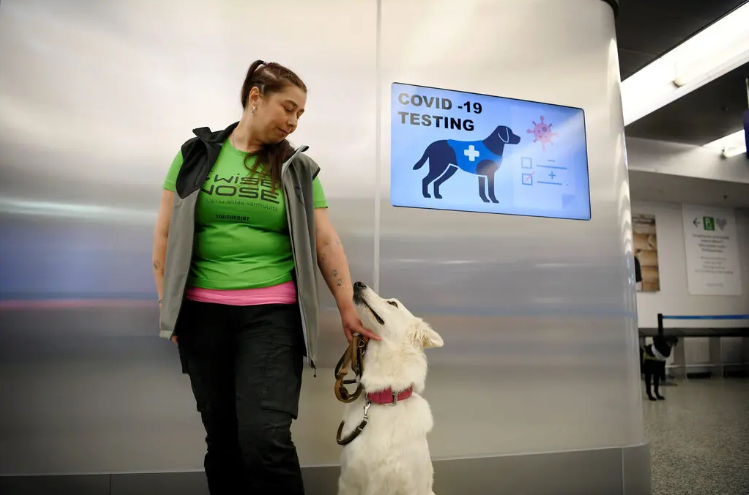我们通过发表论文来表彰学生 STEM 写作比赛的前 11 名获奖者。这是索菲·阿拉滕(Sophie Araten)的作品。

莱赫蒂库瓦,通过路透社
这篇文章由Sophie Araten撰写,15岁,来自新泽西州米尔本的米尔本高中。,是学习网络第二届年度STEM写作比赛的前11名获奖者之一,我们收到了3,741份参赛作品。
Unleash the Tests: The Four-Legged Future of Covid-19 Testing
She’s got pointy ears, a long snout and four strong legs. Meet your new Covid-19 test.
For years dogs have been used to detect bombs and drugs at airports, but our canine friends can also detect certain diseases, such as cancer and Parkinson’s disease, years before the onset of symptoms.
How can they do this? A dog’s nose has between 125 and 300 million scent glands, compared to a human nose, which only has about five million. As a result, a dog’s sense of smell can be up to 100,000 times more sensitive than a human’s. If there were a juicy steak 10 miles away, your dog’s nose could find it. So, when diseases cause people to emit slightly different odors, dogs can detect them.
With Covid-19 occupying the minds of scientists around the world, it was only a matter of time before researchers put dogs to the test to see if they could sniff out the novel coronavirus. Lucky for us, they can. Indeed, researchers have started to train dogs to detect Covid-19 in human sweat samples, and many countries are looking to dogs for cheap, reliable and rapid testing.
It is believed that dogs can recognize a scent produced by volatile organic compounds generated by catabolites, substances produced during replication of the Covid-19 virus. Catabolites exit the body in the form of sweat, which then carries a scent that dogs can detect and be trained to identify.
Dogs in recent trials could pick up the scent of Covid-19 in asymptomatic carriers, and many could even detect Covid-19 earlier than a PCR test could. As Cynthia Otto, the director of the Penn Vet Working Dog Center at the University of Pennsylvania School of Veterinary Medicine, explained to me in an interview: “PCR identifies the RNA associated with the virus. It requires sufficient virus to capture that signal. The dogs pick up the odor of the person’s response to infection. That response could be activated before the virus is in sufficient numbers in the sample collected.”
Another drawback of PCR testing is its speed, often taking several days to get results back. In contrast, dogs could screen hundreds of people in a matter of minutes in busy places such as airports and sports stadiums. Beyond their speed, dogs are also accurate, with the ability to identify positive samples about 95 percent of the time and with a false negativity rate of around one percent in trials. Dr. Otto worries, however, that “If a dog is trained but inadvertently does not actually recognize Covid, then use of this dog would result in false negatives, which would provide inaccurate information and could result in greater spread.”
For this reason, Dr. Otto suggests that “Dogs potentially could be used for screening, rather than diagnosis,” which would allow for “rapid identification of people who need further testing.”
Either way, there is great potential for dogs to help control the pandemic. These inexpensive and quick canine testers could help us get back to a pre-Covid normal.
Works Cited
Hunt, Katie. “Dogs Can be Trained to Detect Covid-19 by Sniffing Human Sweat, Study Suggests.” CNN, 10 Dec. 2020.
Lee, Jack. “New Coronavirus Tests Promise to be Faster, Cheaper and Easier.” Science News, 31 Aug. 2020.
McNeil Jr., Donald. “Dogs Can Detect Malaria. How Useful Is That?” The New York Times, 25 Nov. 2018.
Moysich, Kirsten. “Can Dogs Smell Cancer?” Rosewell Park Cancer Center. 25 Aug. 2020.
Otto, Cynthia. Personal Interview.
Peltier, Elian. “The Nose Needed for This Coronavirus Test Isn’t Yours. It’s a Dog’s.” The New York Times, 23 Sept. 2020.